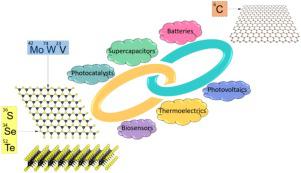Applied Materials Today ( IF 7.2 ) Pub Date : 2020-02-20 , DOI: 10.1016/j.apmt.2020.100600 Jalal Azadmanjiri , Vijay K. Srivastava , Parshant Kumar , Zdeněk Sofer , Jiakang Min , Jiang Gong

|
Two-dimensional (2D) nanomaterials have recently gained interest due to their unique properties which their bulk counterparts do not exhibit. Several 2D nanomaterials have been developed till date, but particularly, transition metal dichalcogenides (TMDs) and graphene have attracted a considerable worldwide research interest due to their excellent properties. The possibility of forming 2D van der Waals (vdW) heterostructures have opened a new way for combining the meritorious properties of graphene and TMDs in a single unit. Due to alteration of Fermi level and Schottky barrier height, the 2D layered graphene/TMD vdW heterostructures could give rise to new properties which are not indigenous either to graphene or TMDs. In this article, we have focused on the recent advances in understanding the characteristics and behavior of 2D layered graphene/TMD heterostructures in various applications. In this context, we firstly discuss the electron transfer characteristics at the interfaces of graphene and TMD heterostructures. Tunable properties of these heterostructures by considering their different architectures are then evaluated. Thirdly, overview approaches in the synthesis of these heterostructures are illustrated. After that, the current conditions of applications of these heterostructures in energy storage, energy conversion, optoelectronic and sensing devices are discussed. The final section remarks the challenges and prospects of 2D vdW graphene and TMD heterostructures.
中文翻译:

石墨烯支撑的2D过渡金属二硫化二氢范德华异质结构
二维(2D)纳米材料由于其独特的性能而近来引起了人们的兴趣,而它们的体积对应物却没有表现出这种性能。迄今为止,已经开发出了几种2D纳米材料,但是特别是过渡金属二卤化物(TMDs)和石墨烯由于其优异的性能而引起了全世界的广泛研究兴趣。形成二维范德华(vdW)异质结构的可能性为在单个单元中组合石墨烯和TMD的优异性能开辟了一条新途径。由于费米能级和肖特基势垒高度的变化,二维层状石墨烯/ TMD vdW异质结构可能会产生石墨烯或TMD都不具有的新特性。在这篇文章中,我们将重点放在了解2D层石墨烯/ TMD异质结构在各种应用中的特性和行为方面的最新进展。在这种情况下,我们首先讨论在石墨烯和TMD异质结构的界面上的电子转移特性。然后,通过考虑它们的不同架构来评估这些异质结构的可调谐特性。第三,说明了这些异质结构的合成中的概述方法。之后,讨论了这些异质结构在能量存储,能量转换,光电和传感设备中的应用现状。最后一部分说明了二维vdW石墨烯和TMD异质结构的挑战和前景。我们首先讨论了石墨烯和TMD异质结构界面的电子转移特性。然后,通过考虑它们的不同架构来评估这些异质结构的可调谐特性。第三,说明了这些异质结构的合成中的概述方法。之后,讨论了这些异质结构在能量存储,能量转换,光电和传感设备中的应用现状。最后一部分说明了二维vdW石墨烯和TMD异质结构的挑战和前景。我们首先讨论了石墨烯和TMD异质结构界面的电子转移特性。然后,通过考虑它们的不同架构来评估这些异质结构的可调谐特性。第三,说明了这些异质结构的合成中的概述方法。之后,讨论了这些异质结构在能量存储,能量转换,光电和传感设备中的应用现状。最后一部分说明了二维vdW石墨烯和TMD异质结构的挑战和前景。讨论了这些异质结构在能量存储,能量转换,光电和传感设备中的应用现状。最后一部分说明了二维vdW石墨烯和TMD异质结构的挑战和前景。讨论了这些异质结构在能量存储,能量转换,光电和传感设备中的应用现状。最后一部分说明了二维vdW石墨烯和TMD异质结构的挑战和前景。









































 京公网安备 11010802027423号
京公网安备 11010802027423号